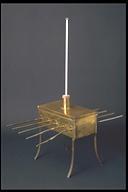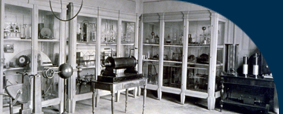|
OUR COLLECTION OF SCIENTIFIC INSTRUMENTS
HEAT |

 |
Ingen-Housz's box modified by Jamin |
 |
Cassetta di Hingen-Housz modificata da Jamin |
| Subjects: heat /relative conductivity of different metals |
Settore: calore/conducibilità relativa di diversi metalli |
| Inventory Number: 24 |
Numero di inventario: 24 |
| Unsigned |
Non firmato |
| 3/4 of the 19th century |
Periodo di costruzione: 3/4 del XIX secolo |
| Brass, copper, zinc, lead, tin, aluminium, iron, nickel, pac.?, glass, paraffin, cork |
Materiale utilizzato: Ottone, rame, zinco, piombo, stagno, alluminio, ferro, nichel; pac.?, vetro, paraffina, sughero |
| 180 X 230 X 280 [mm] |
Dimensioni: 180 x 230 x 280 [mm] |
| |
|
One of the first attempts to determine with a certain degree of precision the conductivity of different materials was that which was suggested by Benjamin Franklin and put into practice by the Dutch physician and physicist Jan Ingenhousz (1730-1799), who was famous mainly for having discovered photosynthesis. In order to compare the conductivity of different materials, he created a device in which some metal bars were completely covered with wax and the extremities of which were dipped into boiling oil. This device had, however, some disadvantages: the liquid inside the box cooled too rapidly; the rods were too short and too close to each other, and therefore, did not allow the observer to evaluate the conductivity of the different materials due to the extreme rapidity with which heat was transmitted. In order to eliminate these slight problems, the French physic Jules Célestin Jamin (1818-1886) modified the design of the instrument. |
Uno dei primi tentativi per determinare con una certa accuratezza la conducibilità di diversi materiali fu quello suggerito dal Franklin e realizzato dal medico e fisico olandese Jan Ingen-Housz (1730-1799), celebre soprattutto per aver scoperto la fotosintesi. Questi per poter comparare la capacità conduttiva di materiali diversi, ideò un apparato in cui alcune sbarre metalliche erano completamente ricoperte di cera ed avevano le loro estremità immerse in olio bollente. Questo apparato aveva però alcuni inconvenienti: il liquido dentro la cassetta si raffreddava troppo rapidamente; le aste, troppo corte e troppo vicine l'una con l'altra, non permettevano all'osservatore di apprezzare le capacità conduttive dei diversi materiali a causa della eccessiva rapidità di trasmissione del calore. Per eliminare tali difetti, il fisico francese Jules Célestin Jamin (1818-1886) operò una modifica nel "design" dell'apparato. |
| |
|
Description: The instrument is made entirely of brass and it consists of a square box with a lid. The box is four feet high, allowing for a burner to be placed under it. On both lateral surfaces five bars of different materials are welded horizontally, each of which is covered with a thin layer of white wax (which melts at about 65°) and they all have the same section. Each bar has writings engraved in brass referring to the kind of material in the following order: ALL (Aluminium), FER( iron), NIC(Nickel), PAC (?), VET (Glass) and RAM (Copper), OTT (Brass), ZIN (Zinc), PIO (Lead), STA (Tin). |
Descrizione: Lo strumento, interamente d'ottone, è costituito da una cassetta rettangolare con coperchio sostenuta ad una certa altezza da quattro piedi per poter inserire sotto la base uno scaldino. Su ciascuna delle due superfici laterali della cassetta sono saldate orizzontalmente cinque sbarrette di diverso materiale, ciascuna ricoperta di un sottile strato di cera bianca (che fonde a circa 65º gradi) ed aventi tutte la medesima sezione. Ogni sbarra reca inciso sull'ottone il tipo di materiale secondo le seguenti successioni: ALL (alluminio), FER (ferro), NIC (nichel), PAC (?), VET (vetro) e RAM (rame), OTT (ottone), ZIN (zinco), PIO (piombo), STA (stagno). |
| |
|
Function: By introducing a liquid into the box and raising its temperature by means of the burner, one eventually notices that the wax on the surface of the bars melts in varying quantities and stops at a certain distance from the hot surface: the longer the distance, the greater the coefficient of conductivity of the material. Putting the different lengths of the melted part of the wax in relation to the length of the copper bar (which is the metal with the highest conductiviy), one can determine an approximate numerical measurement which is proportional to the relative coefficients of conductivity of the different materials as compared to copper. |
Funzionamento: immettendo nella cassetta un liquido e riscaldandolo con uno scaldino, si evidenzia, dopo un certo tempo, che la cera sulle superfici delle sbarrette fonde in quantità diverse, arrestandosi ad una distanza dalla parete calda tanto maggiore quanto più grande è il coefficiente di conduttività del materiale. Confrontando le diverse lunghezze dei tratti di cera fusa rispetto al tratto della sbarretta di rame (che è il metallo con la più alta conduttività), si possono determinare semi-quantitativamente i coefficienti relativi di conduttività delle diverse sostanze rispetto al coefficiente del rame. |
| |
|
Bibliography: Ingen-Housz [1789], tome XXXIV, pp. 68-69; Tyndall [1862], pp. 236-237; Salleron [1864], pp. 270-71. |
Bibliografia: Ingen-Housz [1789], tome XXXIV, pp. 68-69; Tyndall [1862], pp. 236-237; Salleron [1864], pp. 270-71. |
|
|
|

